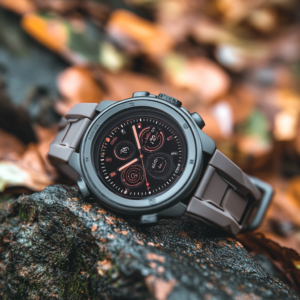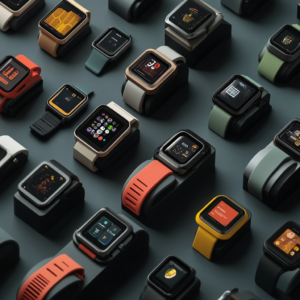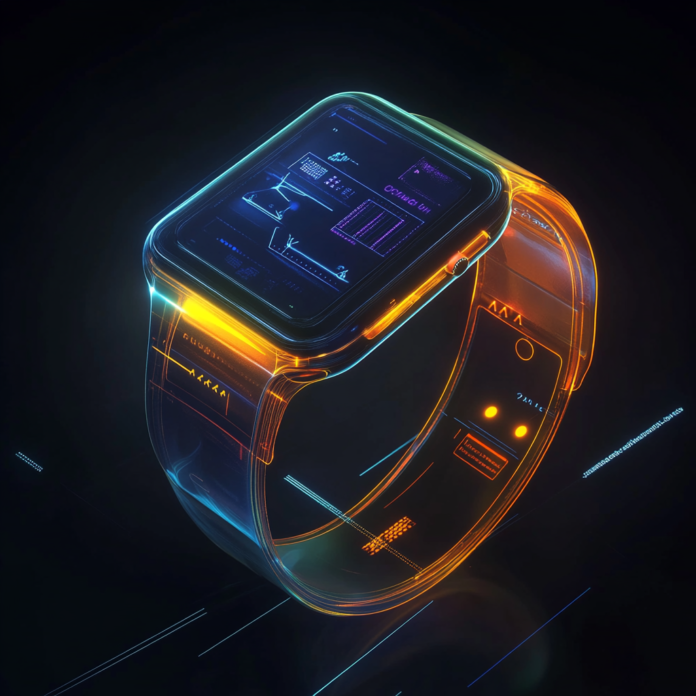1. Introduction
In today’s dynamic digital landscape, wearable technology is evolving at an unprecedented pace. This article, titled “The Future of Wearable Technology: Top Smartwatches Reviewed”, dives deep into the innovations and trends that define our next-generation devices. I have experienced firsthand how smartwatches have transitioned from simple timekeepers to powerful health monitors and communication hubs. In my journey exploring wearable devices, I discovered that The Future of Wearable is not just about adding new features but also about enhancing our daily lives. Throughout this article, I will review top smartwatches, analyze emerging trends, and provide practical tips for making informed decisions. If you’re looking to upgrade your wrist tech, join me as we explore the cutting-edge world of wearable technology.

2. The Evolution of Wearable Technology
Wearable technology has come a long way since the first digital watches appeared. In the early days, devices were limited to basic timekeeping and simple fitness tracking. However, advancements in miniaturization, sensor technology, and wireless connectivity have redefined the landscape. I vividly remember when my first wearable was merely a gadget for tracking steps; today, it monitors heart rate variability, sleep patterns, and even blood oxygen levels. This transformation exemplifies The Future of Wearable: it has evolved into a comprehensive personal assistant that not only tells time but also provides health insights, navigation, and connectivity to your digital life. The evolution is driven by consumer demand for more personalized, data-rich experiences and by relentless innovation in hardware and software integration.
Over the past decade, the wearable market has experienced exponential growth. Early adopters fueled demand with their enthusiasm for novel technology, and soon, major players in the tech industry began investing heavily in research and development. As these devices became more affordable and feature-rich, wearables expanded their appeal from niche fitness enthusiasts to the general public. Today, wearables are no longer just gadgets—they are critical tools for managing health, enhancing productivity, and staying connected in an increasingly digital world. The continuous improvements in battery efficiency and sensor accuracy have further accelerated this trend, paving the way for a future where wearable devices become indispensable parts of our everyday lives.
3. Top Smartwatches Reviewed
In this section, I will review some of the most promising smartwatches on the market. Each device is analyzed based on performance, design, health features, battery life, and overall user experience. My aim is to help you understand which smartwatch best fits your lifestyle and needs. Remember, The Future of Wearable is defined by devices that seamlessly merge style, functionality, and advanced technology.
3.1 Apple Watch Series 8 – A Benchmark in Innovation
The Apple Watch Series 8 sets a high standard in the wearable market. It combines sleek design with a robust suite of health monitoring features. The Series 8 offers advanced sensors for measuring blood oxygen levels, ECG, and even body temperature, making it an invaluable tool for health enthusiasts and professionals alike. Its intuitive interface and integration with the iOS ecosystem make it a favorite for users who value both performance and style. In addition to its core functionalities, the Apple Watch Series 8 features fall detection and emergency SOS capabilities, which add an extra layer of safety. For those interested in exploring further innovations, you can read more about its features in our article on Top 10 Smartphones to Watch in 2025.
3.2 Samsung Galaxy Watch 5 – Versatility in Design
Samsung Galaxy Watch 5 offers a strong alternative for Android users, combining versatility with a modern design. This device features a vibrant display, an array of health tracking options, and robust connectivity features. The Galaxy Watch 5 not only monitors physical activity but also provides insights into stress levels and sleep quality. Its customizable watch faces and interchangeable bands make it an attractive choice for users seeking both functionality and fashion. The device also supports advanced notifications and integrates well with Samsung’s ecosystem, making it a well-rounded choice for tech-savvy individuals. Its competitive pricing and feature set position it as a strong contender in the wearable market.
3.3 Garmin Fenix 7 – For the Adventurous User
For those who lead an active lifestyle and need rugged reliability, the Garmin Fenix 7 is an exceptional choice. Designed with outdoor adventures in mind, this smartwatch boasts advanced GPS tracking, extensive battery life, and features tailored for endurance and outdoor sports. The Fenix 7 tracks metrics such as VO2 max, altitude, and advanced sleep patterns, making it ideal for athletes and adventurers. Its durable construction and water resistance further highlight its suitability for extreme conditions. I have used the Fenix 7 on several hiking trips, and its precision in tracking routes is remarkable. Its robust build and specialized training features make it indispensable for those who push their limits in challenging environments.

4. Trends Shaping the Future of Wearable
The landscape of wearable technology is constantly evolving, with several trends shaping its future. In this section, I will outline key trends that will influence smartwatches in the coming years, highlighting how The Future of Wearable is set to redefine our interaction with technology.
4.1 AI Integration and Health Monitoring
One of the most transformative trends in wearable technology is the integration of artificial intelligence. AI-powered algorithms enable devices to analyze health data with unprecedented accuracy, offering insights that were previously unavailable. For example, smartwatches can now predict potential health issues by monitoring heart rate variability and sleep patterns. These insights empower users to make proactive health decisions. This trend exemplifies The Future of Wearable where smart devices act as comprehensive health assistants. Furthermore, AI integration facilitates more personalized fitness recommendations, ensuring that users receive tailored advice based on their unique physiological data. The convergence of AI with wearables is set to revolutionize preventive healthcare, making early diagnosis and intervention a reality.
4.2 Battery Life and Sustainable Design
As wearable devices become more sophisticated, battery life and sustainable design are increasingly important. Manufacturers are investing in new battery technologies that extend device life without compromising performance. Additionally, there is a growing emphasis on eco-friendly materials and sustainable production practices. This trend not only enhances user convenience by reducing the need for frequent charging but also addresses environmental concerns. Many companies are now exploring solar-powered options and energy-efficient modes to further extend battery performance. These efforts reflect a broader commitment to sustainability, ensuring that as our devices become smarter, they also become more responsible in their environmental footprint.
4.3 Connectivity and Interoperability
Enhanced connectivity is another major trend that will shape the future of smartwatches. With the rollout of 5G and improvements in Bluetooth technology, wearables are becoming more interconnected with other devices and the broader Internet of Things (IoT). This enhanced interoperability allows for seamless data transfer, real-time communication, and integration with smart home systems. For a deeper dive into how enhanced connectivity is revolutionizing tech, check out this excellent review on wearable connectivity from CNET. This trend ensures that smartwatches are not isolated gadgets but integral components of our interconnected world.
5. How to Choose the Best Smartwatch
Choosing the ideal smartwatch can be challenging given the vast array of options available. I have learned that evaluating your personal needs and priorities is essential for making an informed decision.
5.1 Evaluating Your Needs
Start by determining which features matter most to you. Whether you prioritize health monitoring, battery life, design, or app compatibility, create a list of requirements. Consider what functionalities you use most—do you need robust fitness tracking, detailed health insights, or seamless connectivity with your smartphone? Reading detailed reviews and comparisons can help you narrow down your choices. For instance, if advanced health metrics are crucial, look for devices that offer comprehensive monitoring tools. Personal preferences vary, so weigh your options carefully to find a device that meets your unique lifestyle demands.
5.2 Compatibility and Ecosystem
Ensure the smartwatch is compatible with your smartphone and other tech devices. Look for products that work seamlessly within your ecosystem—whether it’s iOS or Android. Compatibility with popular connectivity protocols like Bluetooth and Wi-Fi is essential. Additionally, consider whether the smartwatch integrates with other digital services and apps you frequently use. For example, if you’re invested in a particular platform, make sure the device supports its ecosystem fully. In my research, I often refer to trusted guides like Ultimate Guide to Budget Laptops in 2025 to understand tech integrations better. This research helps ensure a smooth and cohesive user experience.
6. Practical Tips and Best Practices for Wearable Devices
Maximizing the benefits of wearable technology requires practical strategies that can enhance both functionality and longevity.
6.1 Setup and Customization
Choose a smartwatch that allows for extensive customization to match your lifestyle. Personalize watch faces, configure notifications, and set up health tracking parameters that suit your daily routine. Regularly update the device’s firmware to ensure optimal performance and security. To get the most out of your device, use companion apps that provide detailed insights into your health and activity. I recommend watching informative tutorials on YouTube; for example, check out this popular video on setting up your smartwatch for step-by-step guidance. Customization ensures that your wearable truly becomes a personal assistant tailored to your needs.
6.2 Maintenance and Firmware Updates
Keep your smartwatch updated with the latest firmware releases to protect against security vulnerabilities and improve overall functionality. Regular maintenance, such as cleaning the sensors and ensuring proper syncing with your smartphone, can significantly extend the life of your device. It is also important to back up your data regularly so that you never lose critical information. By adhering to these maintenance practices, you ensure that The Future of Wearable technology remains reliable and efficient, offering continuous improvements in performance and security.

7. Market Trends and Consumer Insights
The wearable technology market is expanding rapidly, and recent trends indicate significant growth in both adoption and innovation. Global shipments of smartwatches have increased year-over-year, driven by rising health consciousness and a desire for greater connectivity. Consumers are increasingly seeking devices that offer multi-functionality—combining fitness tracking, communication, and even mobile payments. Moreover, emerging markets are showing strong potential for wearable adoption as technology becomes more affordable. Industry reports from sources like Forbes indicate that wearables will continue to disrupt traditional industries by providing real-time data and personalized experiences. As consumer preferences evolve, companies are investing in research to develop more intuitive, durable, and stylish devices. This ongoing market evolution is not only fueling competition but also driving significant technological advancements.
8. Future Predictions and Expert Opinions
Looking ahead, experts predict that wearable technology will become even more integrated into our daily lives. Advanced features such as real-time health diagnostics, seamless integration with home automation, and augmented reality interfaces are on the horizon. Many industry experts believe that future smartwatches will act as central hubs for personal data, offering insights that help users make better lifestyle decisions. For example, a smartwatch may soon be able to analyze stress levels and provide personalized meditation recommendations in real time. Publications like TechCrunch are already highlighting startups that are developing innovative solutions in the wearable space. As these devices evolve, they will likely become indispensable tools for managing not only personal health but also professional productivity. The convergence of technology, data analytics, and user-centric design will define the next generation of wearable devices, promising a future where technology seamlessly integrates into every aspect of our lives.
Affiliate CTA
For those interested in advanced technology, I have a tool that has helped me a lot in creating the right prompts to generate amazing images. Check out the best AI for creating images and videos here.
9. Conclusion
In conclusion, the landscape of wearable technology is undergoing rapid transformation. This article has reviewed top smartwatches and explored how The Future of Wearable is set to redefine our interaction with technology. By examining devices like the Apple Watch Series 8, Samsung Galaxy Watch 5, and Garmin Fenix 7, I have highlighted the advancements that make these devices indispensable. Emerging trends such as AI integration, improved battery life, sustainable design, and enhanced connectivity underscore a future where wearables will become even more integral to our lives. I encourage you to explore these innovations and consider how they can improve your daily life. The journey into wearable technology is both exciting and transformative, promising a smarter, healthier, and more connected future.
10. Frequently Asked Questions (FAQ)
Q1: What defines wearable technology?
A1: Wearable technology includes devices such as smartwatches, fitness trackers, and other gadgets that can be worn on the body. These devices offer functionalities like health monitoring, notifications, and connectivity with other smart devices.
Q2: How do smartwatches improve health monitoring?
A2: Smartwatches track various health metrics such as heart rate, sleep patterns, and physical activity, providing insights that can help users manage their health and wellness more effectively.
Q3: Are smartwatches compatible with both Android and iOS?
A3: Many smartwatches offer compatibility with both platforms, though some features may be optimized for one ecosystem over the other. It’s important to check compatibility before making a purchase.
Q4: How long does the battery typically last on a modern smartwatch?
A4: Battery life varies by device, but many modern smartwatches can last between one to several days on a single charge, depending on usage and features enabled.
Q5: What are some must-have features in a smartwatch?
A5: Essential features include health monitoring sensors, robust connectivity, customizable interfaces, and long battery life. Additional features may include GPS, water resistance, and integration with third-party apps.
